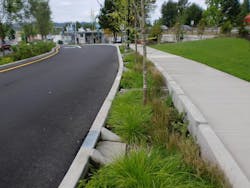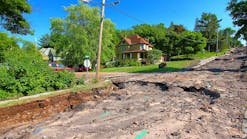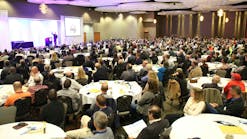Extreme weather strains stormwater infrastructure, prompts proposed solutions
San Diego is a prime example of a city that is facing an urgent need to address the challenges posed by stormwater runoff and aging infrastructure, particularly as extreme weather events become more frequent and severe. The rains of the winter of 2023-2024 served as a stark reminder of San Diego’s vulnerabilities, highlighting the need for a comprehensive strategy to manage stormwater and protect urban infrastructure. In response, a new sales tax initiative has emerged as a potential solution to fund various infrastructure improvements including repair and replacement of failing underground storm drains, maintenance of creeks and flood control conveyance facilities, and installation of green infrastructure. This article will explore how this initiative could help address San Diego’s stormwater problems and serve as an example for other cities.
Stormwater problems and damage in San Diego
Stormwater management has been a long-standing issue in San Diego, as aging infrastructure and increasing urbanization have combined to exacerbate problems with runoff and flooding. In a city that sees relatively dry weather most of the year, heavy rainfall events, such as those during the winter of 2023-2024, often catch communities off-guard. These rains led to widespread flooding, infrastructure damage and environmental degradation, severely impacting both residents and ecosystems.
The winter of 2023-2024 brought unusually heavy storms, causing significant stormwater damage in neighborhoods across San Diego. Streets were flooded, homes were damaged, and businesses were temporarily forced to close due to unsafe conditions. Flooded roadways led to traffic accidents and transportation delays, while some residential areas experienced prolonged flooding, leading to water damage and mold growth in homes. Local infrastructure, particularly the storm drains and sewage systems, were overwhelmed, further contributing to the severity of the flooding.
Environmental damage was also significant. Stormwater runoff carries pollutants like oil, chemicals and debris from urban areas into local rivers, creeks, and ultimately, the ocean. This runoff can devastate aquatic ecosystems, harm wildlife, and degrade water quality, affecting both marine life and human health. As the climate continues to shift toward more extreme weather patterns, these problems are expected to worsen unless comprehensive measures are taken to address stormwater management.
The watershed asset management plan
The city prepared a comprehensive Watershed Asset Management Plan (WAMP) in 2013 and updated in 2021 in response to increasing regulatory pressures, aging infrastructure, and the need for effective budget management. The plan summarized the challenges posed by the city’s aging stormwater infrastructure, as well as the regulatory requirements of the Clean Water Act, which mandates the reduction of pollutants in water bodies that fail to meet water quality standards. The WAMP detailed the costs, the need for upgrades, replacements of existing infrastructure, and the need for new infrastructure to comply with regulatory requirements. This summary was crucial for justifying the necessary budget allocations and prioritizing projects to address the most critical needs. This plan provides a portion of the rationale for the need for additional revenues in the city and helps to explain why the sales tax initiative is needed.
The role of San Diego’s sales tax initiative
San Diego’s current response to these stormwater issues involves a proposed sales tax initiative that will be on the November 2024 ballot. The measure will provide a funding stream that can be used for critical upgrades to infrastructure including stormwater and roads. With much of the city’s stormwater systems aging and underfunded, this tax would provide a vital resource to ensure that future flooding events can be better managed, and long-term investments can be made in green infrastructure.
Sales tax revenue would be used to:
- Upgrade stormwater systems: Replacing outdated pipes, drains and water channels with more robust and modern systems capable of handling increased volumes of stormwater.
- Improve flood management: Expanding and upgrading flood control systems, such as retention basins, flood channels, and pump stations to prevent urban flooding during extreme weather events.
- Improve water quality: Water Quality Improvement Plan (WQIPs) are watershed scale plans developed to meet regulatory requirements for water quality. Each watershed within the city has a unique WQIP, which identifies the highest priority water quality condition(s), or problems, and the corresponding numeric goals, strategies and schedules to address those problems.
- Support green infrastructure: Promoting the implementation of environmentally sustainable solutions, such as stormwater capture and detention, rain gardens, bioswales, permeable pavements, and urban green spaces, to reduce runoff and naturally manage stormwater.
By investing in green infrastructure, San Diego can address both the immediate challenges of stormwater and the long-term impacts of climate change.
Green infrastructure and stormwater management
Green infrastructure refers to a range of practices that mimic natural processes to manage stormwater and create healthier urban environments. Unlike traditional “gray” infrastructure (such as storm drains and pipes), green infrastructure emphasizes sustainability and environmental benefits, while also addressing urban challenges like flooding and pollution.
In the context of stormwater management, green infrastructure can:
- Reduce runoff: By absorbing and filtering rainwater where it falls, green infrastructure reduces the volume of stormwater that enters the city’s drainage system, alleviating pressure on pipes and reducing the risk of flooding.
- Filter pollutants: Vegetation and soil in green infrastructure systems can capture and break down pollutants found in stormwater, such as oil, heavy metals and chemicals. This helps improve water quality and protects ecosystems.
- Increase resilience: Green infrastructure helps cities adapt to changing weather patterns and extreme weather events by providing natural stormwater buffers. Solutions like permeable pavement and rain gardens help urban areas cope with intense rainfall.
Solutions like green roofs, tree trenches and community gardens could be implemented across neighborhoods to not only manage stormwater but also enhance urban landscapes, reduce urban heat and promote biodiversity.
Learning from Los Angeles: Measure W and its impact
San Diego’s initiative can draw inspiration from the success of Measure W, a landmark program passed in Los Angeles in 2018 that provided dedicated funding for stormwater projects. Known as the Safe, Clean Water Program, Measure W established a parcel tax to raise approximately $300 million annually, funding multi-benefit projects that improve stormwater capture, water quality, and promote green infrastructure.
The initiative has had a transformative effect on Los Angeles’ approach to stormwater management:
- Green infrastructure projects: Measure W has enabled Los Angeles to advance a variety of nature-based solutions, including permeable pavements, bioswales, and stormwater capture systems. These systems help slow and filter stormwater, reducing runoff, recharging groundwater supplies, and reducing potable water use through stormwater capture and use.
- Community benefits: In addition to addressing stormwater, Measure W is providing multiple benefits to communities, such as creating new green spaces, reducing urban heat and enhancing air quality. Parks with stormwater capture features and landscaped streetscapes will make neighborhoods more resilient and livable.
- Water conservation: One of the primary goals of Measure W is to improve water sustainability in a drought-prone region. By capturing and using stormwater, the Los Angeles region is predicted to conserve millions of gallons of water that would otherwise have flowed into the ocean. This is particularly crucial in Southern California, where water resources are often scarce.
- Collaborative governance: Measure W established a regional governance structure that brings together stakeholders from local governments, environmental organizations, and the public to oversee the distribution of funds and ensure that projects meet environmental and community goals. This collaborative approach helps advance projects that have broad support and are multi-benefit in nature.
Lessons learned
Stormwater managers in urban areas can learn a great deal from the success of Measure W. By implementing a similar approach, stormwater programs in urban areas can create a sustainable funding stream for stormwater projects and green infrastructure, ensuring that they are well-prepared for future storms and climate challenges.
Key lessons include:
- Long-term investment: Like Los Angeles, San Diego needs a long-term strategy that focuses on sustainable and resilient infrastructure solutions. Green infrastructure should be integrated into urban planning, zoning and public works projects to ensure a coordinated approach to stormwater management.
- Community involvement: Measure W has demonstrated the importance of engaging communities in stormwater projects, ensuring that new infrastructure provides multiple benefits beyond flood control. By involving local stakeholders and prioritizing community needs, San Diego can ensure that its stormwater initiatives not only reduce runoff but also improve quality of life for residents.
- Water sustainability: As climate change brings more intense rainfall and, conversely, longer droughts, San Diego will need to focus on water conservation and stormwater reuse. Stormwater capture systems can help San Diego build more sustainable water supplies by harvesting rainwater during storms and using it during dry periods.
A vision for San Diego’s future
San Diego’s stormwater challenges, especially in light of the damage caused by the rains of 2023-2024, underscore the need for innovative solutions and dedicated funding. The proposed sales tax initiative offers a pathway to address these issues by investing in stormwater infrastructure and promoting green solutions that will not only manage runoff but also enhance the city’s resilience to future storms and climate change.
San Diego can transform its approach to stormwater management, creating a more sustainable, livable and resilient city. With the right investments, San Diego can protect its residents, improve its environment, and ensure that future generations inherit a city that is well-equipped to handle the challenges of a changing climate.
San Diego is the latest example of municipalities recognizing the importance of stormwater management and green infrastructure in the face of extreme weather. We will undoubtedly see more cities embracing the benefits of investing in multi-benefit infrastructure solutions in the future.
Michael Drennan
Michael Drennan is Director of Water Resources and Green Infrastructure in the San Diego office of NV5, a global engineering and technology firm. He also serves as the Government Relations Chair for the American Society of Civil Engineers, San Diego Section.
Lisa Kay
Lisa Kay is chief growth officer and national director of Water Resources for NV5.







